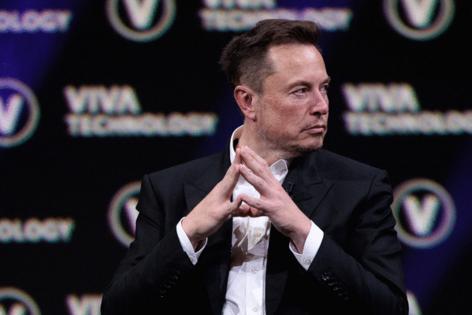Tesla to launch robotaxi service as Detroit moves on
Published in Automotive News
Tesla Inc. CEO Elon Musk says the electric vehicle maker tentatively plans this weekend to launch its robotaxi service — a business Detroit basically abandoned.
Proving the ability of its vehicles to become driverless cabs is critical to Tesla's high-valuation future, according to experts, as its automotive business faces challenges from slowing EV demand and controversial politics around Musk. As competitors like General Motors Co. and Ford Motor Co. focus their autonomy efforts on passenger-vehicle applications instead of expensive robotaxi activations, Tesla is putting to the test its artificial intelligence-powered, camera-only "full self-driving" system that some fear is insufficient for the safe operation of fully driverless cabs.
"Tesla's valuation is premised on this idea that they are suddenly going to start making all this money on these robotaxi services," said Sam Abuelsamid, vice president of market research at auto communications firm Telemetry. "Musk is desperate. Sales and profits are down. More and more people don’t want to be seen in a Tesla. If the core business collapses, the only way the company survives is if they‘re making all this money from robotaxis."
Tesla posted a $420 million profit in the first three months of 2025, which was down 70% year-over-year, when global deliveries fell 13%. Its market capitalization remains more than $1 trillion compared to GM's $46 billion and Ford's $41 billion.
Musk has said the robotaxis, a fleet of reportedly about 10 Model Y SUVs in Austin, Texas, where the company is headquartered, could launch on Sunday in a geofenced area that avoids more complex intersections. The billionaire, however, has said plans could shift because the company is being "super paranoid about safety."
Lawmakers in Texas' Senate and House have requested that Tesla delay the launch until Sept. 1, when a state law requiring authorization and demonstration of safety compliance for autonomous vehicles takes effect.
Branded vehicles have been spotted driving in Austin without drivers. Operators monitoring the vehicles remotely will be able to take control of the vehicles if needed. The service won't launch with the two-seater, steering wheel-free Cybercab the automaker teased at an event last year.
"It all starts next week," said Daniel Ives, an analyst at financial services firm Wedbush Securities Inc. "That’ll be the real test: Them proving autonomy is worth $1 trillion. That's how they get to $2 trillion."
Ives' bet is that if successful, Tesla could license its autonomous technology to other automakers for the vehicles they manufacture, since he says Tesla's AI and engineering is "a decade ahead" of competitors.
"We see almost inevitably that will happen," Ives said.
There remains skepticism, however, that Tesla's system, which doesn't use radar or light detection and ranging known as LiDAR, can fully support robotaxis, Abuelsamid said. Those additional sensors and back-up software that check AI decisions make AVs more expensive, which challenges the profitability of fully driverless cabs.
"The system that they have is not up to the task of doing unsupervised automated driving," Abuelsamid said. "What we’re going to see if we see anything is a bunch of smoke and mirrors."
If that occurs in the robotaxi deployment, it could jeopardize Tesla's vision that its customers' vehicles one day could offer robotaxi services themselves with a software update.
"The idea that they are going to push out an over-the-air update, send it out, and you can give rides and get free money," Abuelsamid said, "that's not ever going to happen."
If that's the case, owning and operating a large robotaxi fleet is expensive compared to other ride-hailing services like Uber and Lyft, where contracted drivers own their vehicles, said Stephanie Brinley, associate director of S&P Global Inc.'s AutoIntelligence.
A recent report from Obi, an app that combine real-time pricing and pick-up times across multiple ride-hailing services, found self-driving car rides from Waymo LLC, a Google-affiliate AV company operating in Phoenix, Los Angeles, San Francisco and Austin, to be consistently more expensive than those other services.
"There are elements to running a robotaxi service that haven’t been solved," Brinley said. "It's impossible to say that if they're not doing it already, they’re behind. We just don't know yet."
The industry, however, is responding to the Tesla launch buzz. Amazon.com Inc.'s AV subsidiary Zoox this week said it launched robotaxi production in Hayward, California. Waymo in California has added more than 80 square miles to its service area. Volkswagen AG's MOIA brand also unveiled the production version of the Level 4 ID. Buzz AD for robotaxis in Europe and North America.
The Detroit Three say they haven't abandoned autonomy. GM last year scrapped funding for its Cruise LLC robotaxi and absorbed its engineers to develop automated driving technology for the passenger vehicles it sells. The Detroit automaker offers hands-free "Level 2" driving on certain highways with Super Cruise, and the company is working toward expanding those areas and offering the technology that allows a driver to take their eyes off the road, which is known as "Level 3" autonomy.
“It wasn’t walking away from autonomy," GM Chief Financial Officer Paul Jacobson said last week at the Deutsche Bank Global Auto Industry Conference. "It was walking away from the robotaxi side of it.”
GM executives determined after spending $10 billion on the business since 2017 that it was too expensive as that automaker pursues development of EVs and a bumpy adoption of electrification elongates the lifespan of gas- and diesel-powered vehicles. A pedestrian crash in 2023 also opened up Cruise to scrutiny from public officials and consumers.
“When we made the tough decision to walk away from the robotaxi business," Jacobson said, "it was really one that was based on capital availability, notwithstanding the fact that autonomy had been experiencing a boom in interest in the capital markets.
"When we went to the markets," he continued, "what we were finding was a lot of people were willing to put in a little bit of money, but they were only willing to put in a little bit of money after GM put in a lot of money. And that was something that when you look at our cost of capital, when you look at our capital priorities, funding a robotaxi operation and building that wasn’t going to be something that we saw as a good, disciplined use of capital going forward, especially against all of our other commitments and priorities."
GM's walk-away from robotaxis followed a similar decision by Ford in 2022 when it absorbed its AV startup partner, Argo AI, after it failed to secure additional investors. That team now is a subsidiary called Latitude AI. Ford offers an in-house-developed Level 2 hands-free highway driving technology called BlueCruise, and executives have said Level 3 eyes-free driving is around the corner.
"We believe our Level 2 and our future Level 3 solutions will be among the best in the industry in execution," Navin Kumar, chief financial officer of Ford's commercial business, Ford Pro, and former director of its AV business, said at the Deutsche Bank conference.
Ford also is working on Level 4 autonomy, a level at which the driver could be removed from the car, Kumar said. That involves a different collection of software components than Levels 2 and 3, but scaling those lower levels builds trust in higher autonomous applications, he said. Kumar emphasized that Ford has knowledgeable leaders like Doug Field, chief EV, digital and design officer, and Sammy Omari, Latitude AI CEO and Ford's executive director of advanced driver-assist system technologies.
Kumar also emphasized Ford's strength in the commercial vehicle market and insights from those kinds of customers with respect to autonomy expanding beyond ride-hailing and into applications for delivery and business use cases.
Stellantis NV — maker of Chrysler, Dodge, Jeep and Ram — had partnered with Waymo on autonomy. The company, for a while, used Chrysler minivans in its robotaxi fleets, though it is no longer doing so.
Stellantis announced in February that it has proven in testing its STLA AutoDrive 1.0 technology, a Level 3 feature capable of handling stop-and-go commuting at speeds of up to 37 mph. Details on when that system, which is focused on dense, urban conditions and daily commuters, will launch on vehicles haven't been shared.
Representatives for GM, Ford and Stellantis said the companies didn't have anything to add about autonomy at this time.
There is a market for automated driving functions in personal vehicles, and robotaxi services may make more sense in densely populated urban settings, said David Whiston, analyst at financial services firm Morningstar Inc.
"Ultimately, it comes down to: Will autonomous vehicles make personal vehicle ownership redundant?" he said. "Even if that is the case, when does that happen? It's still quite a ways off."
©2025 www.detroitnews.com. Visit at detroitnews.com. Distributed by Tribune Content Agency, LLC.








Comments